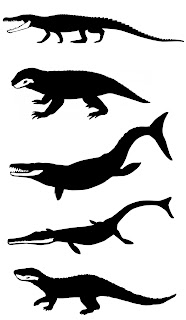New research has revealed the hidden past of crocodiles, showing for the first time how these fierce reptiles evolved and survived in a dinosaur dominated world.
While most modern crocodiles live in freshwater habitats and feed on mammals and fish, their ancient relatives were extremely diverse – with some built for running around like dogs on land and others adapting to life in the open ocean, imitating the feeding behaviour of today's killer whales.
Research published today [11 September] in the journal Proceedings of the Royal Society B shows, for the first time, how the jaws of ancient crocodiles evolved to enable these animals to survive in vastly different environments, all whilst living alongside the dinosaurs 235 to 65 million years ago.
The study was conducted by Tom Stubbs and Dr Emily Rayfield from the University of Bristol, together with Dr Stephanie Pierce from The Royal Veterinary College and Dr Phil Anderson from Duke University.
Tom Stubbs, who led the research at the University of Bristol, said: "The ancestors of today's crocodiles have a fascinating history that is relatively unknown compared to their dinosaur counterparts. They were very different creatures to the ones we are familiar with today, much more diverse and, as this research shows, their ability to adapt was quite remarkable.
"Their evolution and anatomical variation during the Mesozoic Era was exceptional. They evolved lifestyles and feeding ecologies unlike anything seen today."
The research team examined variation in the morphology (shape) and biomechanics (function) of the lower jaws in over 100 ancient crocodiles, using a unique combination of numerical methods.
Dr Stephanie Pierce, from The Royal Veterinary College, said: "We were curious how extinction events and adaptations to extreme environments during the Mesozoic - a period covering over 170 million years - impacted the feeding systems of ancient crocodiles and to do this we focused our efforts on the main food processing bone, the lower jaw."
By analysing variation in the lower jaw, the researchers provide novel insights into how the feeding systems of ancient crocodiles evolved as the group recovered from the devastating end-Triassic extinction event and subsequently responded to the distribution of ecological resources, such as habitat and foodstuff.
For the first time, the research has shown that, following the end-Triassic extinction, ancient crocodiles invaded the Jurassic seas and evolved jaws built primarily for hydrodynamic efficiency to capture agile prey, such as fish. However, only a small range of elongate lower jaw shapes were suitable in Jurassic marine environments.
The study has also revealed that variation peaked again in the Cretaceous, where ancient crocodiles evolved a great variety of lower jaw shapes, as they adapted to a diverse range of feeding ecologies and terrestrial environments, alongside the dinosaurs.
Surprisingly, the lower jaws of Cretaceous crocodiles did not have a great amount of biomechanical variation and, instead, the fossil record points towards novel adaptations in other areas of their anatomy, such as armadillo-like body armour.
Dr Pierce added: "Our results show that the ability to exploit a variety of different food resources and habitats, by evolving many different jaw shapes, was crucial to recovering from the end-Triassic extinction and most likely contributed to the success of Mesozoic crocodiles living in the shadow of the dinosaurs."
link.

No comments:
Post a Comment